

The Nationwide Inpatient Sample1(NIS) and Nationwide Emergency Department Sample2 (NEDS) produced by HCUP include data on hospital stays and disposition of patients from hospital and ED visits. This information is used to provide an estimate of the cost related to hospitalization, and the need for additional care by some patients.
The average length of stay for hospital discharges with any injury diagnosis was approximately 6 days in 2011. Injuries other than musculoskeletal had a slightly longer length of stay of just over 6 days, while musculoskeletal injury patients had an average of slightly more than 5 days. Increasing age was associated with a longer stay, with the longest average stays reported by persons in the 45- to 74-year range. The type of injury also had an impact on length of stay, with open wounds resulting in the longest hospital stay among musculoskeletal injuries. The range for all types of injuries varied between 4 and 7 days. (Reference Table 6A.4.1.1 PDF [3] CSV [4])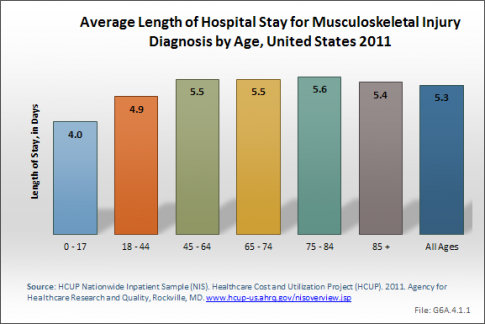
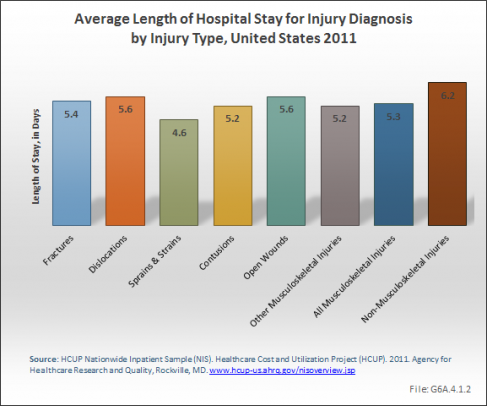
Average hospital charges1 were also slightly higher for patients with non-musculoskeletal injuries, which include brain and spinal injuries, with the exception of average charges for fracture injury patients. However, because of the much higher number of musculoskeletal injury patient stays, the overall total hospital charges for treatment of musculoskeletal injuries were almost twice those of non-musculoskeletal injuries in 2010.
Average total hospital charges for musculoskeletal injuries were $48,700, while they were $52,900 for non-musculoskeletal injuries. The highest average hospital charges were $73,300 for those aged 18 to 44 hears being treated for dislocations.
Total cost for inpatient hospital care for injuries in 2011 was more than $123 million, with musculoskeletal injuries accounting for two-thirds of this total. Fractures, with more than $59.5 million in total hospital charges in 2011, accounted for 72% of musculoskeletal injury charges and nearly one-half (48%) of all injury charges. Increasing age was associated with a steady increase in the proportion of charges for musculoskeletal injury to all injury hospital discharges and in the share of total charges.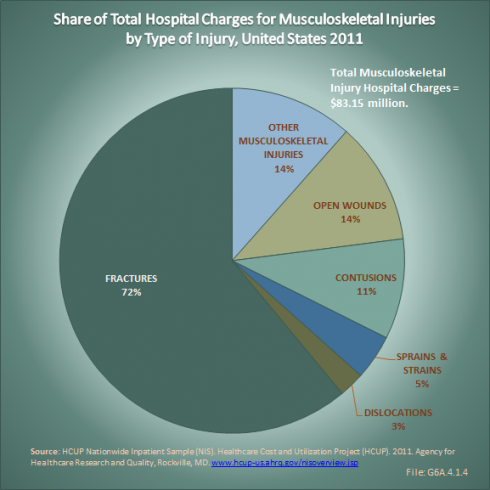
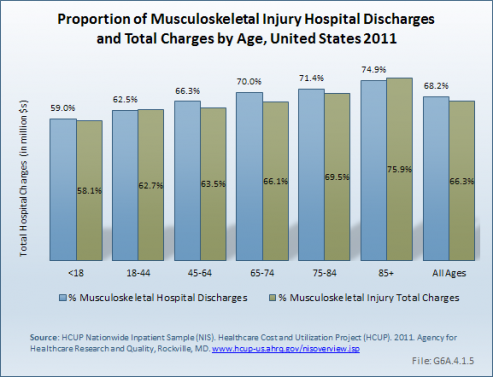
Hospital charges are only part of the cost burden associated with musculoskeletal injuries. Nearly one-half of people discharged from a hospital following an injury are discharged to another type of care facility, such as a short-term, skilled nursing, or intermediate care facility. Still another 13% receive home health care following discharge. These ratios are substantially higher than for all hospital discharges, where 70% of patients are discharged to home without additional care.
Age is clearly a factor in the type of hospital discharge received. By the age of 85 years and older, only 10% of hospital discharges for musculoskeletal injuries are to home without additional home health care, with 76% being discharged to another type of care facility and 10% receiving home health care. With the exception of those under the age of 18 years, fracture injuries are the most likely to result in discharge to additional care. After the age of 45 years, fractures to the lower limb are most likely to result in discharge to additional care, while for those younger than 45 years, a torso fracture is the most likely diagnosis to require additional care. (Reference Table 6A.4.2.1 PDF [5] CSV [6], Table 6A.4.2.3 PDF [7] CSV [8], and Table 6A.4.2.5 PDF [9] CSV [10])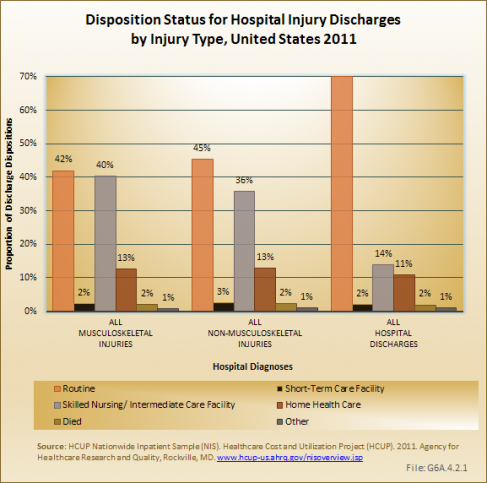
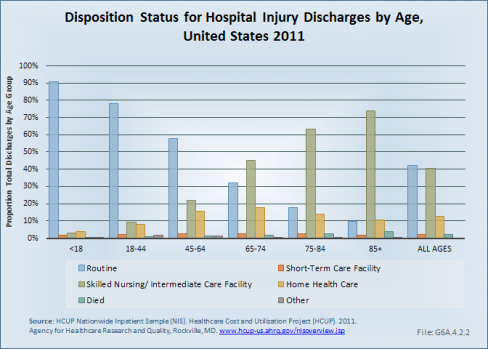
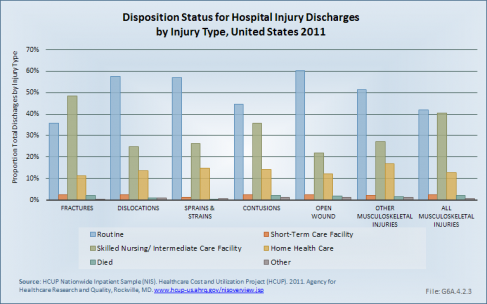
Among those seen in an ED for injury treatment overall, 8% to 9% are admitted to a hospital for further care. About 1% will be sent to a skilled nursing or intermediate care facility. Again, as the age of the patient increases, so does the likelihood of being admitted to the hospital from the ED or being sent to a skilled or intermediate care facility. Very few patients are referred to home health care from the ED. Type of injury follows the same pattern as hospital discharges, with fractures the most likely type of injury to require additional health care outside the ED. Fractures to the torso result in more hospital admissions than upper or lower limb fractures overall, but lower limb fractures for persons age 65 years and older account for more hospital admissions. (Reference Table 6A.4.2.2 PDF [11] CSV [12], Table 6A.4.2.4 PDF [13] CSV [14], and Table 6A.4.2.6 PDF [15] CSV [16])
Links:
[1] http://www.hcup-us.ahrq.gov/nisoverview.jsp
[2] http://www.hcup-us.ahrq.gov/nedsoverview.jsp
[3] https://bmus.latticegroup.com/docs/T6A.4.1.1.pdf
[4] https://bmus.latticegroup.com/docs/T6A.4.1.1.csv
[5] https://bmus.latticegroup.com/docs/T6A.4.2.1.pdf
[6] https://bmus.latticegroup.com/docs/T6A.4.2.1.csv
[7] https://bmus.latticegroup.com/docs/T6A.4.2.3.pdf
[8] https://bmus.latticegroup.com/docs/T6A.4.2.3.csv
[9] https://bmus.latticegroup.com/docs/T6A.4.2.5.pdf
[10] https://bmus.latticegroup.com/docs/T6A.4.2.5.csv
[11] https://bmus.latticegroup.com/docs/T6A.4.2.2.pdf
[12] https://bmus.latticegroup.com/docs/T6A.4.2.2.csv
[13] https://bmus.latticegroup.com/docs/T6A.4.2.4.pdf
[14] https://bmus.latticegroup.com/docs/T6A.4.2.4.csv
[15] https://bmus.latticegroup.com/docs/T6A.4.2.6.pdf
[16] https://bmus.latticegroup.com/docs/T6A.4.2.6.csv